Abstract
The cultures and religious beliefs of Taiwanese indigenous peoples are deeply rooted in ecological protection and environmental ethics. Indigenous peoples emphasize reverence for nature, ecological diversity, sustainable living, resource sharing, and sanctity of nature. Integrating environmental education with indigenous culture can promote biodiversity and ecological conservation while preserving indigenous traditions and fostering sustainable development. This study combined Virtual Reality 360-degree (VR360) technology with indigenous culture to develop a virtual ecological system as a learning tool for environmental education in indigenous elementary schools. The VR360 system simulates the ecological environments of Chichiawan Creek and the Atayal Nanshan Tribe in the mountainous regions of northern Taiwan to provide students with immersive experiences that enhance their learning interest and motivation. Through interactive operations, they can observe the appearance, characteristics, and habitual behaviors of Formosan Landlocked Salmon and other conservation animals to understand the relationship between maintaining biodiversity and ecological balance. The VR360 ecological system enhances learning effectiveness and motivation using low-cost cardboard glasses, making it suitable for promoting indigenous culture and environmental education while reducing the digital divide in remote tribal areas.
1. Introduction
The Atayal Tribe is one of the Taiwanese indigenous peoples, known for its unique culture and traditions. They primarily reside in the mountainous regions of central and northern Taiwan, including Hsinchu, Miaoli, and Taoyuan [1]. Formosan Landlocked Salmon, or Taiwan Masu Salmon, holds significant meaning for the Atayal Tribe, as it resides in Chichiawan Creek in central Taiwan’s mountainous region, a place that has been essential to the Atayal people since ancient times. Traditionally, Taiwanese indigenous peoples relied on river and ocean resources for their livelihood, including fishing, hunting, and gathering. Archaeological research [2] shows that Taiwan Masu Salmon had both cultural and dietary importance in the traditional lifestyle of the Atayal Tribe. However, environmental changes and over-exploitation have threatened its population, leading to a decline in numbers. Efforts have been made by the government to improve their habitats and breeding grounds, as protecting these fish and their ecosystems is crucial for both the Atayal Tribe and Taiwan’s biodiversity.
Environmental education aims to teach people about environmental issues, encouraging friendly behavior towards the environment [3]. The knowledge of indigenous communities and their understanding of local environments, landscapes, and habitats are crucial for global conservation efforts [4]. Combining traditional knowledge with environmental education helps establish more interconnected and profound relationships in sustainable development. This approach contributes to creating more relevant learning experiences, respecting indigenous cultures, protecting local environments, and understanding diverse perspectives on environmental protection held by indigenous peoples [5,6]. Therefore, strengthening ecological conservation for the sustainable development of Taiwanese indigenous peoples and their traditional cultures becomes increasingly important, especially in the context of environmental education.
In the past, science education in Taiwanese elementary and secondary schools may have been influenced by mainstream societal values, leading to less emphasis on the traditional knowledge of minority groups. This oversight could result in neglecting the traditional and cultural values of certain groups within the education system [7]. To ensure that science education extends beyond mainstream scientific knowledge and guides students to grasp the essence of science through exploring the natural insights of diverse cultural groups, it is essential to promote mutual understanding and respect among different ethnic groups and cultural backgrounds [8]. Expanding students’ perspectives can help them appreciate the value of indigenous culture and wisdom, transcending the boundaries of traditional science education and encouraging participation in science learning among students from diverse ethnic and cultural backgrounds [9].
Virtual reality (VR) provides effective learning experiences for environmental education [10], allowing learners to explore virtual ecosystems and overcome geographical barriers. This approach offers a more intuitive and immersive experience compared to traditional teaching methods. Research has shown that VR can create engaging and interactive learning experiences in science education, helping students apply their knowledge to real-life situations [11]. Virtual worlds and immersive simulations enhance participation and improve learning outcomes by connecting students with the natural environment. Hew and Cheung [12] found that K-12 students enjoy learning in virtual environments because they can navigate 3D spaces, make new friends, and take virtual field trips. Thus, VR enriches learning content and captures students’ interest.
VR brings immersive possibilities to different fields of education but also faces notable limitations. The high cost of VR hardware and infrastructure makes it difficult for many schools, especially in underfunded or rural areas, to adopt this technology. Physical issues like motion sickness, eye strain, and fatigue also pose barriers, limiting the duration of VR-based learning. The lack of tactile feedback restricts its use in hands-on fields such as medicine or engineering, where physical manipulation is essential. Social interaction in VR, while possible, often lacks the depth of face-to-face communication, which is important for building interpersonal skills. Furthermore, creating educational VR content can be time-consuming and costly, reducing the breadth of subject matter available. These factors mean that while VR has potential, practical challenges remain for broad, effective integration into educational settings.
Virtual Reality 360-degree (VR360) technology combines virtual reality with 360° panoramic images and videos to facilitate convenient immersive learning experiences using inexpensive head-mounted displays (e.g., Google Cardboard) and smartphones [13]. Experiencing real environments can greatly enhance understanding of natural ecosystems through on-site investigations and virtual simulations, contributing to the accumulation of ecological knowledge [14]. VR360 captures panoramic images of natural environments, providing a new teaching experience to enhance realism and presence through multi-angle viewing and interactive operations, which expands the possibilities for learning [15].
The traditional culture and religious beliefs of Taiwanese indigenous peoples are rich in ecological conservation concepts. They revere nature, protect biodiversity, practice simple living, share resources, and sanctify environments, adhering to environmental ethics. Integrating indigenous culture and wisdom into natural science and ecological education can promote biodiversity and environmental conservation while preserving indigenous cultural heritage and supporting sustainable development. VR simulates real-world scenarios through human sensory experiences, visualizing and demonstrating abstract learning content in a natural and interactive way. This immersive learning experience, beyond what traditional materials can provide, enhances students’ engagement and promotes higher knowledge retention. Therefore, this study integrated VR technology with indigenous culture to develop and promote elementary science curricula, aiming to promote science education and reduce the digital divide in remote tribal areas.
VR can create an immersive learning environment to inspire students’ curiosity and passion for environmental topics. By simulating ecosystems using VR technology, students can explore natural environments without leaving the classroom. For example, Tudor et al. [16] utilized the mobile VR application Google Expeditions (GE) to study the environmental impacts of large-scale developments on nature reserves. The immersive experience increased students’ awareness of environmental challenges and understanding of how these issues affect local flora and fauna. Similarly, Cho and Park [3] used a virtual ecosystem to allow users to experience and manipulate factors affecting the environment, enabling a deeper understanding of global warming effects.
While previous research has extensively explored the potential of VR in environmental education, only a few studies have utilized VR360 as a novel educational tool [17] or the integration of indigenous culture [18]. This study can fill the gap by developing a VR360 ecological system as the educational tool that combines indigenous culture with environmental education, aiming to promote ecological conservation, enhance learning motivation and effectiveness, preserve indigenous traditions, and reduce the digital divide in remote tribal areas. In summary, VR exploration and immersive experiences can significantly enhance learning in environmental education, and indigenous culture can promote biodiversity and ecological conservation. The objective of this study is to develop a VR360 ecological system for learning indigenous cultures and environmental conservation. A teaching experiment is conducted to assess students’ learning effectiveness, motivation, and cognitive load while using the VR360 ecological system to learn about the Taiwan Masu Salmon and other endangered species, the Chichawan Creek habitat, and Atayal indigenous culture. The experimental results can be used to improve the system and support promotional activities. The research questions are listed as follows:
- What is the difference in students’ learning effectiveness when utilizing the VR360 ecological system compared to traditional teaching materials?
- What is the difference in student motivation when utilizing the VR360 ecological system for learning compared to traditional teaching materials?
- What is the difference in students’ cognitive load when utilizing the VR360 ecological system for learning compared to traditional teaching materials?
- What is the students’ level of satisfaction after using the VR360 ecological system for learning indigenous cultures and environmental conservation?
2. Literature Review
The wisdom of living in harmony with nature, passed down from indigenous ancestors, offers invaluable cultural treasures worth preserving. Integrating this wisdom into environmental education can enhance biodiversity, support ecological conservation, preserve cultural heritage, and promote sustainable development. VR provides immersive experiences that visualize abstract concepts in a natural and interactive way to enhance learning motivation and reduce cognitive load. The VR360 ecological system developed in this study effectively promotes indigenous culture and ecological conservation, making it an ideal tool for environmental education in indigenous schools. A review of the literature related to this study is presented as follows.
2.1. Environmental Education
In the modern era, environmental challenges are closely linked to the interactions between humans and ecosystems. Individuals who care for natural environments are more likely to take actions to ensure the sustainable availability of resources. As a result, environmental education emerged in the early 1960s, with ecological education playing the central role in response to urgent environmental crises. Its goal is to raise ecological and environmental awareness and enhance understanding of issues across social, political, ethical, geographical, and emotional aspects to address these problems. The increasing importance of ecological education arises from major environmental issues and its vital role in shaping the values and behaviors of future generations.
As an evolving discipline, environmental education is applied in many ways for various purposes. To enhance individuals’ roles, it must incorporate collaborative strategies such as community education, conflict resolution, social learning, and adaptive management [19]. Environmental education emphasizes local characteristics, including regional knowledge, experiences, values, and practices. However, modern ecological education focuses on exploring the dynamic and complex relationships within environmental systems to influence human behavior, rather than following a straightforward path from attitudes to action [20]. As proposed by Thomashow [21], the concept of “sense of place” is central to many environmental education programs, guiding students to engage with relevant issues and understand global environmental changes.
Personal experiences of a place, combined with information from others or the media about its significance, play a crucial role in creating one’s sense of place. In place-based education, integrating Traditional Ecological Knowledge (TEK)—which encompasses indigenous perspectives on the environment, ecology, and life—is fundamental [22]. TEK evolves over generations through direct engagement with ecosystems, highlighting its local and hands-on nature. This strong connection to local environments and communities emphasizes the practicality and relevance of TEK in education.
The integration of indigenous knowledge into TEK enhances our understanding of natural environments, emphasizing the increasing recognition of indigenous people’s wisdom and its significance [23]. This knowledge, gained through close engagement with ecological environments, is deeply rooted in practical survival strategies and adaptations. It offers profound insights into the local environment, sociocultural dimensions, and the intrinsic connection between life and nature. By incorporating this knowledge into science education, we can better address sociocultural needs and deepen students’ appreciation for the practical relevance of environmental education [24].
2.2. Virtual Reality Technology
In the digital era, advanced technologies present new opportunities to optimize the learning process, with VR emerging as an innovative educational method. VR creates interactive, computer-generated environments that allow users to experience and interact with the real world in a virtual setting [25,26,27]. Researchers and educators highlight its potential to enhance teaching and learning efficiency [28]. Utilizing VR as a learning tool can inspire student engagement, interest, conceptual understanding, and creative learning by encouraging exploration and interaction with information in virtual environments [29]. Particularly in primary education, VR can inspire enthusiasm, improve learning outcomes, enrich learning experience, and foster deeper levels of concentration, significantly helpful to students with lower learning performance.
VR creates a multi-sensory cyber environment to offer a more immersive experience compared to traditional computer-assisted learning content. This immersive experience, coupled with Situated Learning Theory [30], enables learners to interact with other people in a highly realistic environment to facilitate knowledge acquisition. Winn et al. applied VR to learn marine science and conduct virtual sea expeditions [31], finding it useful in helping students connect the learning content with other classroom materials. When using mobile devices for VR applications, the immersive feeling presented in virtual teaching materials makes them more attractive, friendly, and interesting, thereby increasing the potential of VR applications in science education [32].
Using 360° panorama images and videos provides a new possibility to improve learning experiences. The videos are typically produced in 4K (UHD) or higher quality to ensure clarity and detail in visual effects, allowing viewers to appreciate the beauty in the scenes, and thus useful in enhancing immersion [33]. While the use of videos in education is well established, the continuous improvement of VR360 technology enables more immersive and interactive applications in the education sector [34]. Kavanagh et al. proposed using 360° panorama videos as an economical alternative to VR designed with geometric modeling [15]. VR360 is an immersive technology that allows users to experience virtual environments from a spherical perspective. Unlike traditional VR, which requires expensive headsets, VR360 offers a fully immersive experience with affordable head-mounted displays like Google Cardboard. This technology uses 360° cameras to capture panoramic pictures of real scenes. When viewed through VR headsets, users can see as if they are physically present in the real scenes. This makes VR360 particularly effective for education, tourism, and training applications because it creates realistic and engaging experiences that enhance learning and understanding.
Past research has applied 360° panorama videos in immersive ways to present learning content for increasing interest and motivation in scientific research. Applications include guiding students to understand the relevance of science to local communities, implementing VR360 systems in soil and water conservation education, and applying it to learning wetland ecology [35,36,37]. Studies have also evaluated 360° surgical videos, showing higher engagement and attention compared to traditional videos [38]. VR360 holds tremendous potential for interpreting theory and practice through observation and analysis, enhancing motivation and interest in learning. It creates authentic and practical learning experiences, fostering interaction and immersion, making it suitable for explaining phenomena, observation, and knowledge acquisition [39].
2.3. VR Applications in Environmental Education
The use of virtual reality in environmental education can significantly improve students’ understanding and response to current environmental issues. Kim and Dionne [40] metaphorically described science as “a cup of water”, where knowledge represents the water inside the cup. The shape of the water changes based on the container, illustrating that science is a collection of methods and knowledge that shapes our understanding and cognition. To improve science education, we need innovative approaches that go beyond simply teaching scientific theories and facts. Instead, science learning should be rooted in everyday life and societal contexts, helping students construct conceptual knowledge and appreciate the importance of natural environments [41].
VR can simulate diverse ecosystems, allowing students to explore coral reefs, rainforests, or tundras without leaving the classroom. Studies show that these immersive experiences increase students’ understanding of biodiversity and environmental processes [42]. VR can also enable students to visualize and interact with climate change scenarios, such as rising sea levels or glacier melting. By immersing students in future environments, VR has been shown to increase awareness and inspire action for sustainability [43]. Through virtual exploration, students can engage with sustainable farming practices, from water conservation techniques to organic farming, gaining insights into how sustainable practices benefit ecosystems [44]. VR can simulate the effects of pollution on ecosystems, allowing students to observe consequences like plastic accumulation in oceans or urban smog. This experiential learning approach has been found to improve understanding of human impacts on the environment and encourage environmentally responsible behaviors [45].
2.4. VR Applications in Cultural Conservation
VR has emerged as a powerful tool in cultural conservation, enhancing engagement with cultural heritage through immersive experiences. Cecotti [46] explored how fully immersive VR environments can facilitate access to cultural heritage by enabling virtual museum experiences. These platforms allow users to interact with artifacts and artworks in a way that traditional exhibits cannot, fostering deeper emotional connections and understanding of cultural narratives. The study highlights the potential of VR to democratize access to cultural heritage, especially for those unable to visit physical sites due to geographical or financial constraints.
In a comprehensive review, Evangelidis, Sylaiou, and Papadopoulos [47] discussed the integration of VR in cultural heritage preservation. The authors presented various applications that leverage VR technology to recreate historical sites and artifacts, enhancing public engagement and educational outcomes. They argued that VR can effectively bridge the gap between past and present, allowing users to experience history firsthand and stimulating interest in cultural conservation. The paper underscores the role of VR in developing open cultural data repositories and smart applications that can enrich the cultural tourism ecosystem.
Pagano et al. [48] presented the ArkaeVision VR game, which focuses on the ancient site of Paestum in Italy. They detailed how the VR application employs storytelling and user experience design to engage visitors with historical context. By virtually transporting users to significant locations within Paestum, the application enhanced learning through interactive exploration. The study demonstrates that the immersive nature of VR can significantly improve users’ emotional engagement and understanding of cultural heritage, thereby fostering a greater appreciation for historical preservation efforts. The above studies illustrate the transformative potential of VR in cultural conservation, providing innovative avenues for education, engagement, and preservation of cultural heritage.
3. Materials and Methods
This study combined indigenous culture with ecological conservation to create a VR360 ecological system as a learning tool for environmental education in indigenous elementary schools. The objective is to provide elementary students with interactive and immersive experiences to enhance their learning interest and motivation and promote environmental conservation. Additionally, this initiative aims to help bridge the digital divide for indigenous communities, promoting equitable access to digital resources and supporting culturally relevant environmental education. A teaching experiment is conducted to evaluate their learning effectiveness, motivation, cognitive load, and satisfaction with the VR360 ecological system. The following sections describe the learning content, system development, and research design in this study.
3.1. Learning Content
The Atayal Tribe is one of the Taiwanese indigenous peoples residing in the central and mountainous regions of northern Taiwan. Despite its relatively small population, the Atayal Tribe is renowned for its unique cultural traditions. The mountainous regions of central and northern Taiwan, home to the Atayal Tribe, feature lush landscapes, rivers, and lakes that are integral to its way of life. Living in harmony with nature, the Atayal people have accumulated profound knowledge and wisdom about their ecological environments, including detailed observations and experiences related to flora, fauna, and aquatic ecosystems. Traditionally, the Atayal Tribe reveres nature, perceiving all elements in the natural world as possessing a spiritual presence. This cultural perspective can serve as a catalyst for instilling environmental awareness among generations.
This study combined the indigenous culture of the Atayal Tribe with the learning topic of “aquatic ecology” in the elementary school curriculum. The integration enables students to gain a better understanding of ecological environments and acquire the Atayal wisdom of protecting and sustainably utilizing natural resources. The elements selected in this study focused on investigating the ecological environments of Chichiawan Creek and the Atayal Nanshan Tribe in northern Taiwan. Observation points and learning content were selected based on the habitats of the Taiwan Masu Salmon and the residential areas of the Atayal Tribe. Figure 1 shows the planned observation points for developing the VR360 ecological system, including the Atayal Cultural Center, Taiwan Masu Salmon habitats, the Chichawan Archaeological Site, Taoshan Waterfall, Rahaw Creak, and the Taiwan Masu Salmon Ecology Center. This study utilized the Satellite View on Google Maps to facilitate the visualization of these ecological observation points. The researchers also planned several aquatic animals commonly seen in the Chichiawan Creek area (Figure 2).
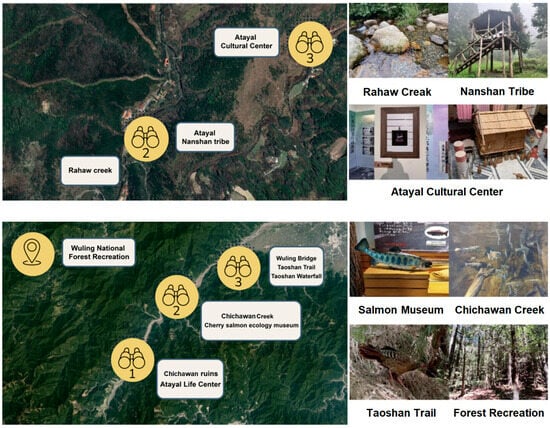
Figure 1.
Observation points in Chichawan Creek and Atayal Nanshan Tribe areas.
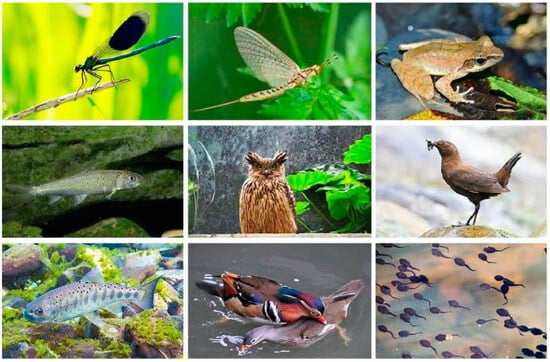
Figure 2.
Aquatic animals commonly seen in the Chichiawan Creek area.
- Aquatic insects (damselflies, mayflies);
- Amphibians (Sod’s frog, tadpoles);
- Fish (Taiwan Masu Salmon, Taiwan’s shovel-jaw carp);
- Birds (yellow-bellied owl, river blackbird, mandarin duck).
The VR360 ecological system provides an effective way for students to learn about the interactions between an ecosystem and its environment, highlighting important challenges and conservation issues. This study aligns with the elementary school curriculum about aquatic animals and endangered species, raising awareness of protecting aquatic environments and observing behaviors of various aquatic animals. By providing students with virtual experiences, the VR360 ecological system can develop a sense of responsibility for environmental conservation. The objective is to help students understand the complex interactions between animals and their habitats while addressing critical environmental issues and fostering a long-term dedication to protecting nature.
The instructional design of learning units aims to enhance students’ understanding of the distinct features of aquatic creatures and their living environments. Students are encouraged to observe the behaviors of various aquatic animals, enhancing a deeper understanding of their ecological features. This approach can foster students’ awareness about the ecology of aquatic creatures while encouraging a commitment to environmental conservation. Through the learning process, students can gain deeper insights into the roles and significance of aquatic ecology to develop an appreciation for biodiversity. The learning content of the VR360 ecological system includes “Atayal Culture”, “Natural Ecology”, and “Environment and History”, aligning seamlessly with the relevant learning units of the natural science curricula in elementary schools (see Table 1).

Table 1.
Learning content and objectives of the VR360 ecological system.
3.2. VR360 Ecological System
This study utilized the Unity3D 2020, Google VR software development kit (SDK) v1.190.0, and Blender 4.0 3D modeling software as the primary design tools to develop the VR360 ecological system. The required materials of virtual scenes were captured on-site using a RICOH THETA 360 camera. The 360° images were then pasted onto 3D spherical models to create immersive virtual environments for observation points (Figure 3). The C# language was selected in Visual Studio 2022 to develop the interactive programs for triggering events. The images of the user interface were drawn by Adobe photoshop. The development process included the following: (1) designing VR learning content; (2) capturing photos and videos of indigenous tribes and ecological environments; (3) recording voices and editing textual descriptions; (4) developing virtual scenes and a user interface for the ecological environment; (5) exporting the VR360 system as an application for installation on a smartphone with an Android operating system. Figure 4 shows the flowchart to understand the key steps for developing the VR360 APK.
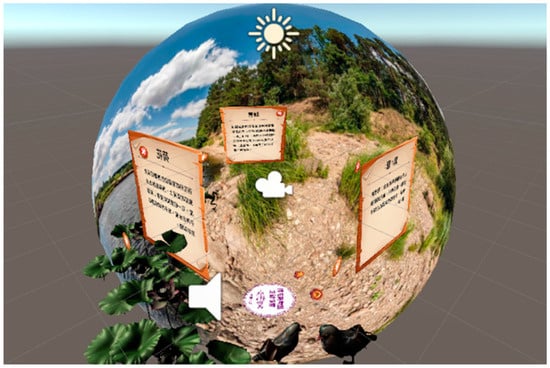
Figure 3.
Pasting 360° panorama images onto the 3D spherical model.
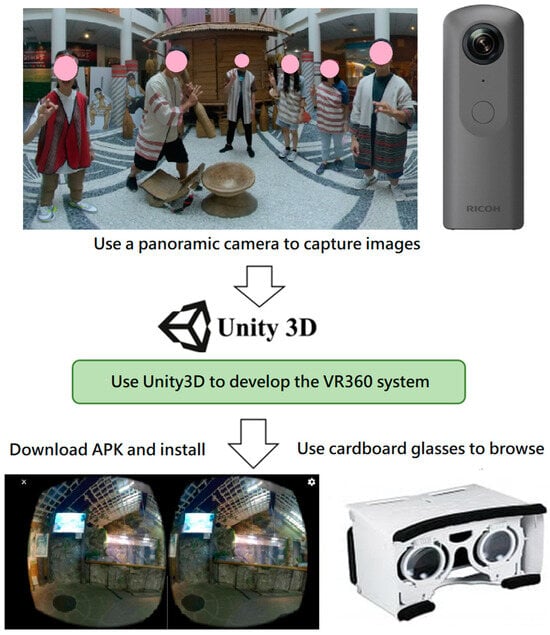
Figure 4.
Flowchart of developing the VR360 APK for the Atayal Cultural Center.
The process of developing a virtual Taiwan Masu Salmon model included (1) creating the 3D fish model, (2) pasting texture images, (3) adding the skeletal system, (4) simulating the motion, and (5) replicating the completed 3D fish model. This study used Blender to create the 3D fish model and used Photo Studio to remove the background image to obtain the texture materials, which were pasted onto the surface of the 3D fish model (Figure 5). When adding the skeletal system, special attention must be paid to setting the functional areas to prevent other parts of the body from deformation. To allow fish models to move and rotate freely within a virtual 3D environment, this study developed movement patterns based on their natural behaviors. A State Transition Diagram was used to analyze the movement characteristics of fish, with the time required for state transitions following a random distribution. Transition probabilities between states were then defined, and a stochastic model was developed to simulate fish movements. Due to the probabilistic nature of this mathematical model, even fish of the same species exhibit unique movement paths. For different species, the model can also simulate distinct movement behaviors by adjusting the transition probabilities between states.
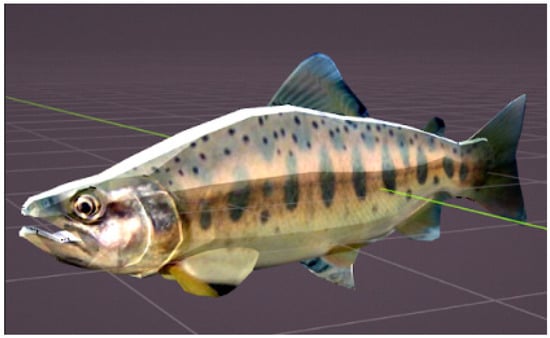
Figure 5.
Pasting texture onto the 3D model of Taiwan Masu Salmon.
Using simplified models can create a sense of artificiality, potentially distracting students and reducing immersion, which may impact learning outcomes. Unnatural movements in virtual environments can draw attention away from educational content and increase cognitive load, making it harder for students to focus. To enhance engagement and understanding, developing 3D models with realistic, species-specific behaviors would align the virtual experience more closely with real ecosystems. This improvement could make the virtual environment more intuitive and effective for learning, supporting a deeper connection with the material and fostering better educational outcomes.
When developing the VR360 ecological system, this study utilized Unity3D to create the virtual scenes of observation points in the Atayal Nanshan Tribe and Chichiawan Creek ecological areas. The 3D models of endangered species, like Taiwan Masu Salmon (Figure 6) and Formosan Reeve’s Muntjac (Figure 7), were incorporated into the virtual scenes. The integration of endangered species into the VR360 ecological system allows learners to observe and interact with these animals to better understand their behaviors and habitats. The combination of virtual and tangible elements creates a more immersive and natural experience, delivering a vivid encounter with wild animals. This approach provides an interactive experience, enabling learners to understand the importance of protecting endangered species and their ecological environments. Additionally, it helps promote the concept of ecological conservation by showing the delicate balance of an ecosystem and the crucial role each species plays within it. Unlike the virtual scenes created by 3D geometric modeling, VR360 technology replicates panoramic pictures of natural landscapes, more suitable for environmental education.
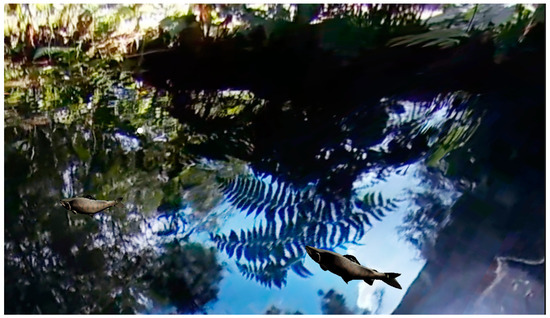
Figure 6.
Taiwan Masu Salmon in the virtual scene of Chichawan Creek.
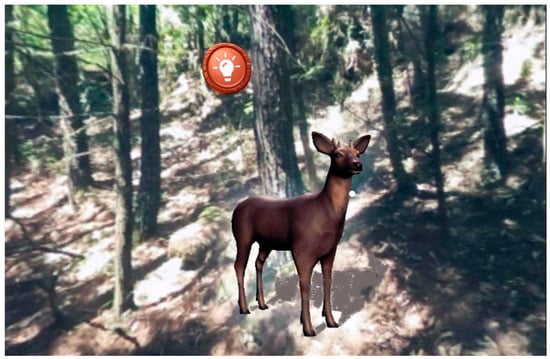
Figure 7.
A Formosan Reeve’s Muntjac in the virtual scene of Taoshan Trail.
After the completion of the VR360 ecological system, it was exported as an application for installation. Using a smartphone and cardboard glasses, the users can immerse themselves in the virtual scene for learning. Figure 8 and Figure 9 show the stereo view and visual perception of the virtual Taiwan Masu Salmon Ecology Center, respectively. Users can experience a stereoscopic view of the VR360 ecological system within each VR scene. When using cardboard glasses, users can perceive depth through a binocular illusion generated by the stereo image pair. Each VR scene, though resembling the pictures taken by a camera, is displayed as a pair of stereo images. To fully experience the 3D visual effect, users need to wear cardboard glasses to activate this stereo perception. Cardboard glasses have the advantages of portability, easy operation, lower expense, and the ability to display 360° panoramic images. Within the virtual environment, users can conduct observations from different viewing angles or focus on an icon to trigger the event like showing detailed information, scene transitions, and playing audio or video.
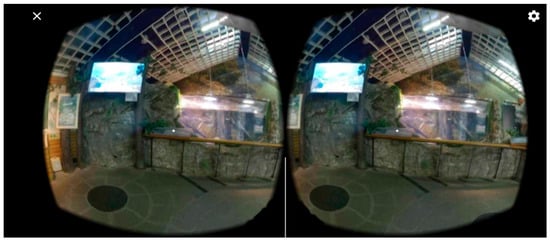
Figure 8.
The stereo view of the VR360 ecological system.
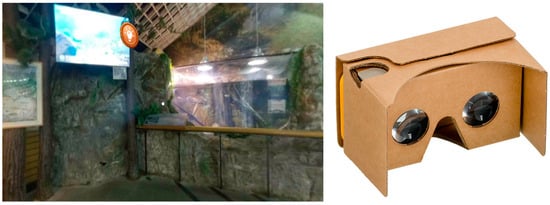
Figure 9.
The visual perception created by the binocular illusion of cardboard glasses.
When the VR360 ecological system is completed, it can be installed on a smartphone. Students can use cardboard glasses as the viewing device and place the smartphone in the designated compartment to experience the immersive virtual scenes. After clicking the ‘Start’ button, the user can enter the lobby of the VR360 ecological system. There are five icons connecting to the specified observation points: (1) Atayal Tribe, (2) Nanshan Tribe, (3) Taiwan Masu Salmon, (4) Taoshan Trail, and (5) Shei-Pa National Park, each containing several virtual scenes for exploration and observation. The user has to accomplish the assigned tasks in each observation point. Upon entering a virtual scene, the user may see various animals belonging to this ecological environment. The virtual scenes are equipped with a progress bar to display the percentage of ongoing progress. Completing the corresponding scenes is necessary for the user to advance to the next level.
Figure 10 displays the architecture diagram of the VR360 ecological system, which includes virtual scenes such as Chichawan Creek (showing the Taiwan Masu Salmon), Taoshan Trail 2 (showing Swinhoe’s Pheasant), and Taoshan Trail 3 (showing the Formosan Reeve’s Muntjac), as can be seen in the figure. After entering a VR360 scene, the user can explore the environment following tasks outlined in the learning worksheet. The virtual scene includes road signs guiding users to other areas, icons providing information about local species, and functions offering content on the ecological environment. Users are encouraged to freely explore indigenous culture, observe relevant ecological information, and complete the tasks assigned in their worksheets.
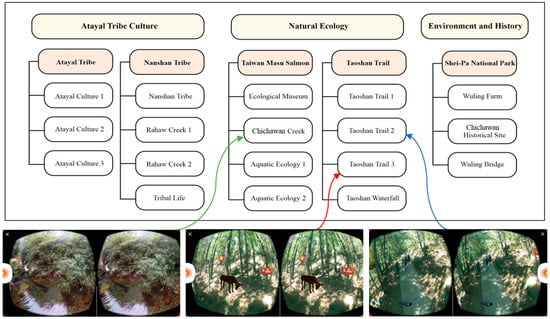
Figure 10.
Architecture diagram of the VR360 ecological system.
3.3. Research Design
This study employed a quasi-experimental design by dividing participants into experimental and control groups. The experimental group used the VR360 ecological system for learning, while the control group received instruction through the traditional teaching method (using PowerPoint and video teaching materials). There are 23 VR modules in the VR360 ecological system and it takes about 5 min to view each VR module. The total instruction took two hours for both groups to complete the learning activity. Both groups completed pre-tests and post-tests to evaluate the impact of different teaching methods on their learning outcomes (20 min for each test). They filled out the learning motivation and cognitive load scales after the instruction (5 min for each scale). In addition, the experimental group had to complete a system satisfaction questionnaire (10 min) to gain insights into their learning experiences and provide feedback on the VR360 ecological system. The total teaching experiment took about 3 h. The flowchart of the teaching experiment is shown in Figure 11.
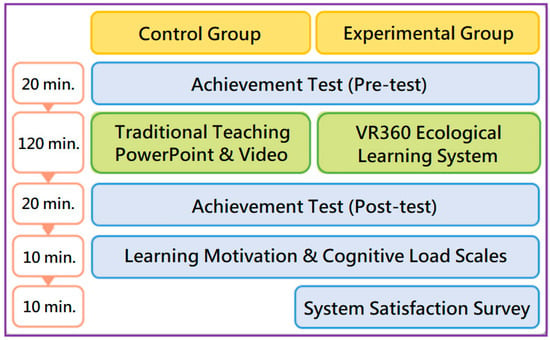
Figure 11.
Flowchart of the teaching experiment for both groups.
This study utilized four research tools: the achievement test, the learning motivation and cognitive load scales, and the system satisfaction questionnaire, as described below.
- Achievement Test
This study designed an achievement test based on the learning content to investigate the difference in learning effectiveness between the two groups before and after learning. The achievement test comprised 16 multiple-choice questions, each offering four selection options (see Appendix A). The test questions were reviewed by two science teachers to ensure their reliability and alignment with learning objectives.
- Learning Motivation Scale
This study employed a learning motivation scale (see Appendix B) to measure participants’ learning motivation after the treatment and analyzed the differences resulting from different teaching methods. This study used Hwang, Yang, and Wang’s learning motivation scale [49], which adopted a five-point Likert scale as the evaluative mechanism with the scores ranging from “strongly agree = 5” to “strongly disagree = 1” and a higher score representing a higher level of learning motivation.
- Cognitive Load Scale
To investigate the difference in cognitive load between the two groups, this study used the cognitive load scale revised by Hwang, Yang, and Wang [49], originally designed by Thomashow [21]. The scale comprised eight questions and employed a five-point Likert scale as the evaluation mechanism. The scores range from “strongly agree = 5” to “strongly disagree = 1”, with a lower score indicating a lower level of cognitive load. The dimensions of the cognitive load scale include “mental load”, which evaluates the difficulty of the learning content or task challenge, and “mental effort”, which evaluates the amount of mental resources required by the learning method (see Appendix C).
- System Satisfaction Questionnaire
This questionnaire is designed to assess user satisfaction with the VR360 ecological system regarding its cognitive usefulness and ease of use. This study revised the system satisfaction questionnaire proposed by Hwang, Yang, and Wang [49], employing the Technology Acceptance Model (TAM) with a five-point Likert scale as the evaluation mechanism. The scores range from “strongly agree = 5” to “strongly disagree = 1” and a higher score indicates a higher level of learner satisfaction with the system.
The rationale for selecting these research questions is grounded in understanding the unique educational impacts of VR-based learning compared to traditional methods, especially in the context of environmental and cultural conservation. Each research question is intended to address specific aspects of learning that VR technology may influence, including knowledge acquisition, motivation, cognitive load, and user satisfaction. These research questions ensure a comprehensive evaluation of VR360’s effectiveness in education, addressing both its advantages and potential limitations in fostering knowledge, learning engagement, cognitive load, and system satisfaction.
4. Teaching Experiment
The teaching experiment used convenience sampling, recruiting two classes with a total of 67 fifth-grade students from an indigenous elementary school in northern Taiwan as research subjects. Informed consent from parents or guardians was obtained to ensure they understood the study’s purpose, methods, potential risks, and benefits, as well as their child’s rights as a participant. Parental consent ensured that they were fully informed and voluntarily agreed to their child’s involvement. This process is essential for ethical standards and is often required by institutional review boards.
The participants were divided into two groups: an experimental group of 34 students in one class and a control group of 33 students in the other. Using 30 or more samples per group in the teaching experiment ensured statistical robustness, result reliability, and improved generalizability, providing a stronger foundation for interpreting the educational interventions. Both groups completed a pre-test before beginning the teaching activities. Following this, the experimental group used the VR360 ecological system to learn about indigenous culture and environmental conservation, while the control group used PowerPoint and instructional videos covering the same content. The teaching experiment for the two groups using different teaching methods is shown in Figure 12.
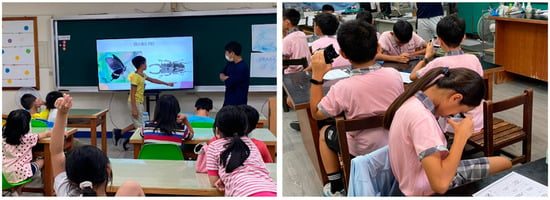
Figure 12.
The experimental group (Right: using the VR360 ecological system) and the control group (Left: using PowerPoint and instructional videos).
4.1. Statistical Methodologies
This study used four main statistical methods to investigate the learning effectiveness, learning motivation, cognitive load, and system satisfaction:
- Analysis of Covariance (ANCOVA): This method adjusts for potential confounding variables when comparing group outcomes. In this study, it accounts for initial performance differences, ensuring a fair assessment of VR360’s impact on learning.
- Paired Sample t-Test: this method compares two related measurements, like pre- and post-test scores in the same group, to assess significant changes over time.
- Independent Sample t-Test: This test evaluates the difference between the averages of two independent groups, such as experimental and control groups, to see if one method significantly outperformed the other. It produces a t-value and p-value to show if observed differences are statistically meaningful.
- Descriptive Statistics: This approach summarizes central data points like means and standard deviations, providing an overview of score patterns and variability across groups. This combination clarifies overall trends and validates claims about VR360’s effectiveness in enhancing learning outcomes.
A brief overview of the statistical terms is given below. These terms help determine if findings represent genuine effects rather than random variation.
- t-value: In a t-test, the t-value measures the difference between two group means, adjusting for data variability. A higher t suggests a stronger difference.
- p-value: The p-value shows the likelihood of observed results occurring by chance. If p < 0.05, the results are statistically significant, meaning they likely represent a real effect.
- Significance: when results are “statistically significant” (p < 0.05), they are likely not due to random chance.
- Standard Deviation (SD): SD measures data spread around the mean. A smaller SD indicates less variability in the data set.
4.2. Learning Effectiveness
According to the descriptive statistics in Table 2, the experimental group had a pre-test score of 55.88 with a standard deviation of 15.99. After the intervention, the post-test score increased to 98.67 with a standard deviation of 9.35. The control group had a pre-test score of 60.60 with a standard deviation of 11.74. After the intervention, the post-test score increased to 75.00 with a standard deviation of 9.24.

Table 2.
Descriptive statistics of the pre-test and post-test scores for both groups.
A paired samples t-test was used to assess the difference in learning achievement before and after the treatment for the two groups. According to the results in Table 3, both groups achieved significant progress after learning with different methods. A significant difference between the mean scores of the pre-test and post-test was found for the experimental group (t = 16.05, p < 0.001). Observation of the test scores reveals that the post-test score is higher than the pre-test score. Similarly, the results achieved a significant difference between the pre-test and post-test scores (t = 7.10, p < 0.001) for the control group. The results of the paired samples t-tests reveal a significant improvement in learning effectiveness for both groups after learning with their teaching methods.

Table 3.
Results of paired samples t-tests in learning achievement for both groups.
A one-way ANCOVA is a statistical method that examines differences between group means while adjusting for the influence of covariates, or other factors that might affect the outcome. By controlling for such variables, ANCOVA isolates the effect of the primary independent variable on the dependent variable. In this study, it enables an accurate comparison of learning outcomes between the experimental group and the control group, providing a clearer view of VR360’s effectiveness in enhancing learning by adjusting for students’ prior knowledge or related factors.
A one-way ANCOVA was conducted to compare the learning effectiveness between the two groups. Before the analysis, the assumption of variance homogeneity was tested and no significance was found (F = 3.961, p > 0.05), confirming that ANCOVA can be conducted. The results of one-way ANCOVA are shown in Table 4 with F = 222.231 and p < 0.001, indicating a significant difference between the two groups in learning effectiveness due to different teaching methods. According to the results in Table 2, the experimental group made more progress than the control group, so the learning effectiveness of the VR360 ecological system is higher than that of the traditional teaching method.

Table 4.
Statistical results of one-way ANCOVA.
4.3. Learning Motivation
An independent sample t-test was conducted to compare the learning motivation of the two groups after learning with different methods. The experimental group had an average score of 4.26 with a standard deviation of 0.64, while the control group had an average score of 3.90 with a standard deviation of 0.68 (Table 5). A significant difference was found between the two groups (t = 2.24, p = 0.029 < 0.05), indicating that the VR360 ecological system could enhance students’ learning motivation.

Table 5.
Independent sample t-test results of learning motivation.
4.4. Cognitive Load
An independent sample t-test was conducted to compare the cognitive load of the two groups after learning with different methods. The experimental group had an average score of 1.64 with a standard deviation of 0.74, while the control group had an average score of 2.32 with a standard deviation of 0.64 (Table 6). A significant difference was found between the two groups (t = −3.99, p < 0.001), indicating that the VR360 ecological system could reduce students’ cognitive load.

Table 6.
Independent sample t-test results of cognitive load.
We can further examine the dimensional cognitive load, namely mental load and mental effort. In the dimension of mental load, the experimental group had an average score of 1.67 with a standard deviation of 0.80. In contrast, the control group had an average score of 2.32 with a standard deviation of 0.64. The results in Table 7 revealed a significant difference in mental load between the two groups, with the control group exhibiting a higher mental load than the experimental group (t = −3.72, p < 0.001). In the dimension of mental effort, the experimental group had an average score of 1.61 with a standard deviation of 0.73. In contrast, the control group had an average score of 2.32 with a standard deviation of 0.82. Similarly, the independent sample t-test results showed a significant difference in mental effort between the two groups, with the control group exhibiting higher mental effort than the experimental group (t = −3.78, p < 0.001).

Table 7.
Independent sample t-test results of mental load and mental effort.
4.5. System Satisfaction
According to the results in Table 8, the overall average score of the satisfaction questionnaire for the VR360 ecological system is 4.38, indicating a level between “very satisfied” and “satisfied”. Further analysis of each item reveals that the average scores of all items exceed 4. Specifically, the items receiving higher scores include the following: “The learning approach enriches the learning experience” (score = 4.50), “The VR360 system provides useful information when needed” (score = 4.56), and “I quickly learned to use the VR360 system” (score = 4.53). Regarding individual dimensions, the average score for the “Usefulness” dimension is 4.41, and the average score for the “Ease of Use” dimension is 4.34. This suggests that students were mostly satisfied with the VR360 ecological system, considering its usefulness and ease of use.

Table 8.
System satisfaction for the VR360 ecological system.
5. Discussion
In this study, both groups exhibited improved learning outcomes after learning with different methods, and the analysis results of ANCOVA revealed significant differences in learning outcomes between the two groups. Utilizing the VR360 ecological system, the experimental group performed better than the control group receiving traditional instruction. This disparity highlights the effectiveness of the VR360 ecological system in providing a virtual and immersive ecological environment, enabling learners to actively explore natural ecology and indigenous culture. This approach contributes to an enriched learning experience, fostering a deeper understanding of the interconnection between indigenous culture and the ecological environment. These findings align with the research results of Barbalios et al. [50], showing how virtual environments can help improve understanding indigenous culture and concepts of ecological conservation.
Further analysis of the difference in learning motivation between the two groups revealed a higher level of enthusiasm in the experimental group. The results of this study are consistent with previous research [51], indicating that immersive virtual field trips can enhance elementary students’ sense of presence and motivation. Students using the VR360 ecological system can interact with virtual animals and observe natural ecological settings. Triggering icons in the virtual scene allows students to obtain more information about ecological features and indigenous cultures, making learning more interesting than simply viewing images and videos. The immersive experience enables students to actively explore and observe various aspects of indigenous culture and endangered species, contributing to a more effective learning process.
This study also discovered that students using the VR360 ecological system experienced lower cognitive load compared to those using traditional teaching methods. The VR360 system can alleviate cognitive load for learning about natural ecology, which aligns with the findings of Liu et al. [52]. VR technology typically offers a more concrete and realistic experience [53], allowing students to interact with and observe in the virtual world, enhancing their understanding of ecological concepts. By designing the learning content to incorporate attractive features of virtual reality, it is suggested that when students can explore the virtual environment themselves and conduct observations, they are more likely to transform abstract concepts into substantial learning outcomes. This helps reduce cognitive load, making it easier for students to comprehend and absorb ecological knowledge. The use of cardboard VR allows learners to focus on the 360° natural landscapes without the need for complex controls or settings, providing a more relaxed learning experience than traditional materials that require extensive reading.
The duration of students’ VR360 engagement in this study would be valuable information to assess how discomfort affected their learning experience. There are 23 modules in the VR360 ecological system, and it takes about 5 min to view one VR module. Some participants occasionally felt physical discomfort while wearing cardboard glasses, particularly experiencing symptoms like dizziness and nausea due to motion sickness [54]. Reports of mild dizziness and headaches suggest that, even if the sessions were relatively short, the physical discomfort may have influenced students’ concentration and focus. When experiencing any physical discomfort, students may find it harder to stay engaged, which could impact learning outcomes.
Since the VR sessions were short, it would be insightful for future research to consider the potential effects of longer VR applications, as extended sessions could increase discomfort, posing challenges for regular or extended classroom use. On the other hand, students, especially teenagers, may adapt to VR over time. This gradual acclimatization could help reduce discomfort as they become more familiar with the VR environment and the sensations it induces. Investigating whether students adapt to these interactive experiences in a classroom setting could provide valuable insights into implementing VR as a sustainable educational tool. This approach would allow educators to consider strategies for phased or intermittent VR instruction, balancing immersion with comfort to support more effective and focused learning experiences.
6. Conclusions
Indigenous peoples have a deep understanding of ecological conservation and their living environment. Their sustainable and mutually beneficial ways of using natural resources should be preserved. This study combines VR with indigenous culture and the concepts of ecological conservation to enhance learning effectiveness and motivation in environmental education. The goal is to promote environmental conservation and bridge the digital divide among indigenous communities.
6.1. Research Findings
This study developed the VR360 ecological system by integrating indigenous culture with natural ecology, significantly improving learning outcomes compared to traditional teaching methods. The analysis results show that students in the experimental group had higher learning motivation and lower cognitive load than the control group using conventional teaching methods. The VR360 ecological system provided a more relaxed and efficient learning experience, where participants were satisfied with the system, appreciating its realistic scenes and user-friendly interface. Although some students reported mild discomfort, such as dizziness and headaches, the overall satisfaction with the interface design, learning content, and user experience was positive.
6.2. Future Research Directions
Building on the research results of this study, future investigations can expand the application of VR360 and the integration of indigenous culture into an effective tool for environmental education across diverse academic domains as listed below.
- Ecological cultures and characteristics of distinct indigenous groups
The diverse landscape in Taiwan is home to various indigenous ethnic groups, each with unique ecological cultures as well as local flora and fauna. For example, the Zou tribe, residing in high mountain areas, has a profound mountain culture where animals hold spiritual significance. Exploring wildlife in the Zou Tribe’s habitat, such as the Formosa serow, goats, and various aquatic species, helps understand the connection between these animals and their ecological environments, highlighting the tribe’s ecological uniqueness.
- Learning traditional skills within the context of natural ecology
VR can be used to teach traditional skills of indigenous people, such as plant-based weaving, fishing techniques, and hunting practices. In the virtual world, students can learn the practical applications of these skills and explore the balance between ecological sustainability and traditional practices. Combining VR360 technology with indigenous culture creates an immersive learning experience, enhancing appreciation and understanding of diverse cultures and their environments. This research has significant implications for cross-cultural and environmental education.
- Extending the application of VR360 beyond Taiwan
Emphasizing the adaptability of the VR360 approach can broaden its relevance beyond Taiwan, illustrating its potential use in various educational settings around the world. For instance, VR technology has been successfully implemented in cultural education in diverse regions, allowing students to engage with local histories and environmental conservation efforts. This adaptability demonstrates the versatility of VR as a pedagogical tool, which can be tailored to meet the needs of different student demographics while enhancing their understanding of ecological systems and cultural heritage. Additionally, by drawing parallels to similar VR applications in other contexts, such as in indigenous education in Australia or environmental education in the Amazon, we can illustrate the broader implications of this study. This approach not only strengthens the argument for VR’s novelty but also contributes to the growing body of research on immersive technologies in education, showcasing the potential for VR to facilitate cross-cultural learning and environmental awareness in various global contexts.
Author Contributions
Investigation: J.-C.H.; formal analysis: J.-C.H.; methodology: W.T.; writing—review, and editing: W.T. All authors have read and agreed to the published version of the manuscript.
Funding
This research was funded by the National Science and Technology Council (NSTC), Taiwan under the grant number 112-2420-H-007-003.
Institutional Review Board Statement
The study was conducted in accordance with the Declaration of Helsinki, and approved by the Research Ethics Committee of National Tsing Hua University, Taiwan (REC No. 11008HT096, 1 January 2022).
Informed Consent Statement
Informed consent was obtained from all subjects involved in the study.
Data Availability Statement
Dataset available on request from the authors.
Conflicts of Interest
The authors declare no conflicts of interest.
Appendix A
- Achievement Test (16 multiple-choice questions)
- 1.
- What era does the Chichawan Creek site belong to?(1) The Metal Age (2) Paleolithic Age (3) Neolithic Age (4) Iron Age
- 2.
- What is the traditional tool of the Atayal tribe for pounding grains?(1) Pestle and mortar (2) Crushing tool (3) Grinding bowl (4) Fishing tool
- 3.
- What skill is used to assess Atayal women’s social status and talent?(1) Planting (2) Hunting (3) Weaving (4) Harvesting
- 4.
- What is the traditional name for Atayal houses constructed with bamboo?(1) Bamboo house (2) Main house (no inaan) (3) Treasure house (4) Thatched house
- 5.
- How is the Atayal granary constructed to prevent dampness and avoid rats?(1) Watchtower of Atayal (2) Elevated construction (3) Half-underground house (4) Stone slab house
- 6.
- What color is typically predominant in Atayal tribe clothing?(1) Green (2) Red (3) Yellow (4) Blue
- 7.
- What does facial tattooing signify for Atayal women?(1) Hunting (2) Weaving (3) Cooking (4) Fishing
- 8.
- Which tribe is located near Rahaw Creek?(1) Nanshan Tribe (2) Shanoh Tribe (3) Four Seasons Tribe (4) Sqoyaw Tribe
- 9.
- Which water environment is known as the “hometown of Taiwan Masu Salmon”?(1) Chichawan Creek (2) Jhuoshuei River (3) Lanyang River (4) Zengwun River
- 10.
- What type of fish is the Taiwan Masu Salmon?(1) Warmwater fish (2) Coldwater fish (3) Hotwater fish (4) Icy water fish
- 11.
- Where do Cherry Salmon lay their eggs?(1) Drifting with the current in the water (2) Shallow riverbeds with good water flow on gravel ground (3) Spawn on land (4) In crevices of rocky reefs
- 12.
- How many years does Taiwan Masu Salmon typically live?(1) 3–4 years (2) 1–2 years (3) 5–6 years (4) 7–8 years
- 13.
- What is the object in the picture?(1) Orange pearl (2) Plankton (3) Fish eggs (4) Fish oil

- 14.
- What bird species is shown in the picture below?(1) Swinhoe’s Pheasant (2) Sparrow (3) Chinese Bulbul (4) Mikado Pheasant

- 15.
- What animal is shown in the picture below?(1) Cow (2) Reeve’s Muntjac (3) Formosan Sambar Deer (4) Dog

- 16.
- What plant is shown in the picture below?(1) Kuban Royal Palm (2) Taiwan Red Pine (3) Taiwan Box (4) Palimara Alstonia

Appendix B
- Learning Motivation Scale (6 evaluation items)
| Items | Strongly Agree | Agree | Neutral | Disagree | Strongly Disagree |
| |||||
| |||||
| |||||
| |||||
| |||||
|
Appendix C
- Cognitive Load Scale (8 evaluation items)
| Dimension | Item | Strongly Agree | Agree | Neutral | Disagree | Strongly Disagree |
| Mental Load |
| |||||
| ||||||
| ||||||
| ||||||
| ||||||
| Mental Effort |
| |||||
| ||||||
|
References
- Council of Indigenous Peoples. The Tribes in Taiwan: Atayal. 2023. Available online: https://www.cip.gov.tw/en/index.html (accessed on 10 May 2024).
- Forestry and Nature Conservation Agency. Formosan Landlocked Salmon Wildlife Refuge. 2022. Available online: https://conservation.forest.gov.tw/EN/0002160 (accessed on 10 May 2024).
- Cho, Y.; Park, K.S. Designing Immersive Virtual Reality Simulation for Environmental Science Education. Electronics 2023, 12, 315. [Google Scholar] [CrossRef]
- Prize, U.E.; Conservation Matters, L. The State of Indigenous Peoples’ and Local Communities’ Lands and Territories. 2021. Available online: https://wwflac.awsassets.panda.org/downloads/report_the_state_of_the_indigenous_peoples_and_local_communities_lands_and_territories_1.pdf (accessed on 10 May 2024).
- Chandra, D.V. Re-Examining the Importance of Indigenous Perspectives in the Western Environmental Education for Sustainability: “From Tribal to Mainstream Education”. J. Teach. Educ. Sustain. 2014, 16, 117–127. [Google Scholar] [CrossRef]
- Hamlin, M.L. “Yo soy indígena”: Identifying and using traditional ecological knowledge (TEK) to make the teaching of science culturally responsive for Maya girls. Cult. Stud. Sci. Educ. 2013, 8, 759–776. [Google Scholar] [CrossRef]
- Fu, L.-Y. Who’s ScienceEducation? ScienceEducation in Multicultural Perspective. Curric. Instr. Q. 2004, 7, 91–108. [Google Scholar]
- Zidny, R.; Sjöström, J.; Eilks, I. A multi-perspective reflection on how indigenous knowledge and related ideas can improve science education for sustainability. Sci. Educ. 2020, 29, 145–185. [Google Scholar] [CrossRef]
- De Beer, J.; Whitlock, E. Indigenous knowledge in the life sciences classroom: Put on your de Bono hats! Am. Biol. Teach. 2009, 71, 209–216. [Google Scholar] [CrossRef]
- Gibson, D.; Aldrich, C.; Prensky, M. Games and Simulations in Online Learning: Research and Development Frameworks; IGI Global: Hershey, PA, USA, 2006. [Google Scholar]
- Markowitz, D.M.; Bailenson, J.N. Virtual reality and the psychology of climate change. Curr. Opin. Psychol. 2021, 42, 60–65. [Google Scholar] [CrossRef] [PubMed]
- Hew, K.F.; Cheung, W.S. Use of three-dimensional (3-D) immersive virtual worlds in K-12 and higher education settings: A review of the research. Br. J. Educ. Technol. 2010, 41, 33–55. [Google Scholar] [CrossRef]
- Pirker, J.; Dengel, A. The potential of 360° virtual reality videos and real VR for education—A literature review. IEEE Comput. Graph. Appl. 2021, 41, 76–89. [Google Scholar] [CrossRef]
- Knapp, D.; Barrie, E. Content evaluation of an environmental science field trip. J. Sci. Educ. Technol. 2001, 10, 351–357. [Google Scholar] [CrossRef]
- Kavanagh, S.; Luxton-Reilly, A.; Wuensche, B.; Plimmer, B. A systematic review of virtual reality in education. Themes Sci. Technol. Educ. 2017, 10, 85–119. [Google Scholar]
- Tudor, A.-D.; Minocha, S.; Collins, M.; Tilling, S. Mobile virtual reality for environmental education. J. Virtual Stud. 2018, 9, 25–36. [Google Scholar]
- Snelson, C.; Hsu, Y.-C. Educational 360-degree videos in virtual reality: A scoping review of the emerging research. TechTrends 2019, 64, 404–412. [Google Scholar] [CrossRef]
- López, M.; Wolske, M. Indigenous Knowledge and Virtual Reality: Enhancing Education Through Immersive Experiences. J. Interact. Learn. Res. 2021, 32, 123–145. [Google Scholar]
- Monroe, M.C.; Andrews, E.; Biedenweg, K. A framework for environmental education strategies. Appl. Environ. Educ. Commun. 2008, 6, 205–216. [Google Scholar] [CrossRef]
- Marcinkowski, T.; Reid, A. Reviews of research on the attitude–behavior relationship and their implications for future environmental education research. Environ. Educ. Res. 2019, 25, 459–471. [Google Scholar] [CrossRef]
- Thomashow, M. Bringing the Biosphere Home: Learning to Perceive Global Environmental Change; MIT Press: Cambridge, MA, USA, 2001. [Google Scholar]
- Martin, J.F.; Roy, E.D.; Diemont, S.A.; Ferguson, B.G. Traditional Ecological Knowledge (TEK): Ideas, inspiration, and designs for ecological engineering. Ecol. Eng. 2010, 36, 839–849. [Google Scholar] [CrossRef]
- Shava, S. The representation of indigenous knowledges. In International Handbook of Research on Environmental Education; Routledge: Abingdon, UK, 2013; pp. 384–393. [Google Scholar]
- Van Lopik, W. Traditional ecological knowledge in the tribal college classroom. J. Environ. Stud. Sci. 2012, 2, 341–345. [Google Scholar] [CrossRef]
- Araiza-Alba, P.; Keane, T.; Chen, W.S.; Kaufman, J. Immersive virtual reality as a tool to learn problem-solving skills. Comput. Educ. 2021, 164, 104121. [Google Scholar] [CrossRef]
- Araiza-Alba, P.; Keane, T.; Kaufman, J. Are we ready for virtual reality in K-12 classrooms? Technol. Pedagog. Educ. 2022, 31, 471–491. [Google Scholar] [CrossRef]
- Wu, J.; Guo, R.; Wang, Z.; Zeng, R. Integrating spherical video-based virtual reality into elementary school students’ scientific inquiry instruction: Effects on their problem-solving performance. Interact. Learn. Environ. 2021, 29, 496–509. [Google Scholar] [CrossRef]
- Schott, C.; Marshall, S. Virtual reality and situated experiential education: A conceptualization and exploratory trial. J. Comput. Assist. Learn. 2018, 34, 843–852. [Google Scholar] [CrossRef]
- Tsichouridis, C.; Batsila, M.; Vavougios, D.; Ioannidis, G. Virtual and Augmented Reality in Science Teaching and Learning. In The Impact of the 4th Industrial Revolution on Engineering Education; Springer: Cham, Switzerland, 2019. [Google Scholar]
- Hu-Au, E.; Lee, J. Virtual reality in education: A tool for learning in the experience age. Int. J. Innov. Educ. 2017, 4, 215–226. [Google Scholar] [CrossRef]
- Winn, W.; Stahr, F.; Sarason, C.; Fruland, R.; Oppenheimer, P.; Lee, Y. Learning oceanography from a computer simulation compared with direct experience at sea. J. Res. Sci. Teach. 2005, 43, 25–42. [Google Scholar] [CrossRef]
- Martín-Gutiérrez, J.; Mora, C.E.; Añorbe-Díaz, B.; González-Marrero, A. Virtual Technologies Trends in Education. Eurasia J. Math. Sci. Technol. Educ. 2017, 13, 469–486. [Google Scholar] [CrossRef]
- Lee, N.; Choi, W.; Lee, S. Development of an 360-degree virtual reality video-based immersive cycle training system for physical enhancement in older adults: A feasibility study. BMC Geriatr. 2021, 21, 325. [Google Scholar] [CrossRef]
- Rosendahl, P.; Wagner, I. 360° videos in education—A systematic literature review on application areas and future potentials. Educ. Inf. Technol. 2023, 29, 1319–1355. [Google Scholar] [CrossRef]
- Boda, P.A.; Brown, B. Priming urban learners’ attitudes toward the relevancy of science: A mixed-methods study testing the importance of context. J. Res. Sci. Teach. 2019, 57, 567–596. [Google Scholar] [CrossRef]
- Ou, K.L.; Chu, S.T.; Tarng, W. Development of a Virtual Wetland Ecological System Using VR360 degrees Panoramic Technology for Environmental Education. Land 2021, 10, 829. [Google Scholar] [CrossRef]
- Tsai, H.-H.; Hou, X.-Y.; Chang, C.-T.; Tsai, C.-Y.; Yu, P.-T.; Roan, J.-S.; Chiou, K.-C. Interactive Contents with 360-Degree Panorama Virtual Reality for Soil and Water Conservation Outdoor Classroom. In Proceedings of the 2020 International Symposium on Educational Technology (ISET), Bangkok, Thailand, 24–27 August 2020. [Google Scholar]
- Harrington, C.M.; Kavanagh, D.O.; Ballester, G.W.; Ballester, A.W.; Dicker, P.; Traynor, O.; Hill, A.; Tierney, S. 360 operative videos: A randomised cross-over study evaluating attentiveness and information retention. J. Surg. Educ. 2018, 75, 993–1000. [Google Scholar] [CrossRef]
- Boda, P.A.; Brown, B. Designing for relationality in virtual reality: Context-specific learning as a primer for content relevancy. J. Sci. Educ. Technol. 2020, 29, 691–702. [Google Scholar] [CrossRef]
- Kim, E.-J.A.; Dionne, L. Traditional ecological knowledge in science education and its integration in grades 7 and 8 Canadian science curriculum documents. Can. J. Sci. Math. Technol. Educ. 2014, 14, 311–329. [Google Scholar] [CrossRef]
- Østergaard, E. Earth at rest: Aesthetic experience and students’ grounding in science education. Sci. Educ. 2017, 26, 557–582. [Google Scholar] [CrossRef]
- Park, J.H.; Boo, J.H.; Park, K.S. Design and Development of an Immersive Virtual Reality Simulation for Environmental Education. J. Korea Inst. Inf. Commun. Eng. 2022, 26, 541–547. [Google Scholar]
- Dhunnoo, Y.; Carter, A.; O’hare, D.; Birt, J.; Skitmore, M. Improving Climate Change Awareness through Immersive Virtual Reality Communication: A Case Study. Sustainability 2023, 15, 12969. [Google Scholar] [CrossRef]
- Nguyen, A.; Francis, M.; Windfeld, E.; Lhermie, G.; Kim, K. Developing an immersive virtual farm simulation for engaging and effective public education about the dairy industry. Comput. Graph. 2024, 118, 173–183. [Google Scholar] [CrossRef]
- Ahn, S.J.; Bailenson, J.N.; Park, D. Short- and long-term effects of embodied experiences in immersive virtual environments on environmental locus of control and behavior. Comput. Hum. Behav. 2014, 39, 235–245. [Google Scholar] [CrossRef]
- Cecotti, H. Cultural Heritage in Fully Immersive Virtual Reality. Virtual Worlds 2022, 1, 82–102. [Google Scholar] [CrossRef]
- Evangelidis, K.; Sylaiou, S.; Papadopoulos, T. Mergin’ Mode: Mixed Reality and Geoinformatics for Monument Demonstration. Appl. Sci. 2020, 10, 3826. [Google Scholar] [CrossRef]
- Pagano, A.; Palombini, A.; Bozzelli, G.; De Nino, M.; Cerato, I.; Ricciardi, S. ArkaeVision VR Game: User Experience Research between Real and Virtual Paestum. Appl. Sci. 2020, 10, 3182. [Google Scholar] [CrossRef]
- Hwang, G.-J.; Yang, L.-H.; Wang, S.-Y. A concept map-embedded educational computer game for improving students’ learning performance in natural science courses. Comput. Educ. 2013, 69, 121–130. [Google Scholar] [CrossRef]
- Barbalios, N.; Ioannidou, I.; Tzionas, P.; Paraskeuopoulos, S. A model supported interactive virtual environment for natural resource sharing in environmental education. Comput. Educ. 2013, 62, 231–248. [Google Scholar] [CrossRef]
- Cheng, K.-H.; Tsai, C.-C. A case study of immersive virtual field trips in an elementary classroom: Students’ learning experience and teacher-student interaction behaviors. Comput. Educ. 2019, 140, 103600. [Google Scholar] [CrossRef]
- Liu, R.; Wang, L.; Koszalka, T.A.; Wan, K. Effects of immersive virtual reality classrooms on students’ academic achievement, motivation and cognitive load in science lessons. J. Comput. Assist. Learn. 2022, 38, 1422–1433. [Google Scholar] [CrossRef]
- Dan, A.; Reiner, M. EEG-based cognitive load of processing events in 3D virtual worlds is lower than processing events in 2D displays. Int. J. Psychophysiol. 2017, 122, 75–84. [Google Scholar] [CrossRef]
- Caserman, P.; Garcia-Agundez, A.; Zerban, A.G.; Göbel, S. Cybersickness in current-generation virtual reality head-mounted displays: Systematic review and outlook. Virtual Real. 2021, 25, 1153–1170. [Google Scholar] [CrossRef]
Disclaimer/Publisher’s Note: The statements, opinions and data contained in all publications are solely those of the individual author(s) and contributor(s) and not of MDPI and/or the editor(s). MDPI and/or the editor(s) disclaim responsibility for any injury to people or property resulting from any ideas, methods, instructions or products referred to in the content. |
© 2024 by the authors. Licensee MDPI, Basel, Switzerland. This article is an open access article distributed under the terms and conditions of the Creative Commons Attribution (CC BY) license (https://creativecommons.org/licenses/by/4.0/).